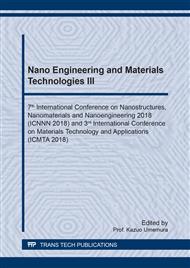p.142
p.148
p.155
p.160
p.167
p.173
p.178
p.185
p.190
Performance Study on Modified UHMWPE Composites Water Lubricated Bearing Material
Abstract:
Ultrahigh Molecular Weight polyethylene (UHMWPE) is modified by adding Polyimide (PI) and the performance of composite marerial is studied. The density as well as the Shore hardess of the modified UHMWPE composite increases with the percentage of PI. The average water absorption rate is less than 0.03%. the composites reaches steady-state creep after 287h’s compression. Electrical insulation capacity of the composite material with 1% PI is about equivalent to that of Thordon material and then the composite material with 5% PI composite materials and the performance of Tenmat material is poor. An experiment in artificial seawater is conduct as the test contact mode is the pin/disc contact, in which the pin sample is modified UHMWPE composite material, the results show that the friction coefficient of the modified UHMWPE composite is the smallest, the wear height of the UHMWPE/PI polymer is smaller than that of the other seven groups, and the PI content of composite is 1% and the wear height is the smallest, wear weight of tin bronze sn10-2 in pair of UHMWPE/PI polymer composites and Thordon and Tenma is in the same stage. As the PI weight percent increases, the depth and width of furrow cutting increase, and there are obvious characteristics of large PI particles shedding, and there are holes on the worn surface. There are obivous cracks on the worn surface of the Thordon material, and the characteristics of abrasive wear is shown in Tenmat material.
Info:
Periodical:
Pages:
167-172
Citation:
Online since:
March 2019
Authors:
Keywords:
Price:
Сopyright:
© 2019 Trans Tech Publications Ltd. All Rights Reserved
Share:
Citation:


